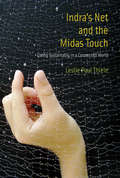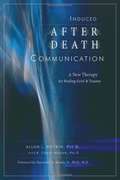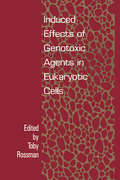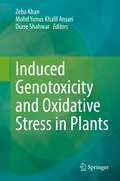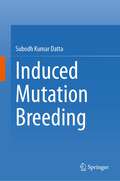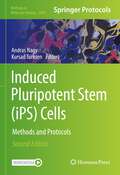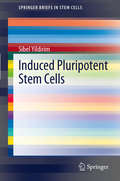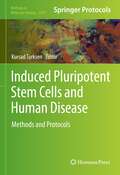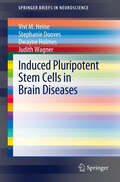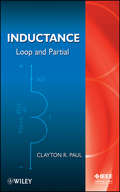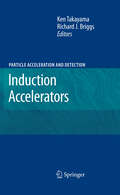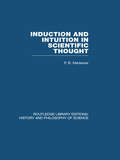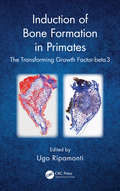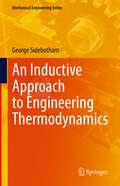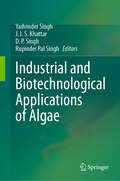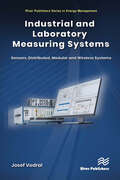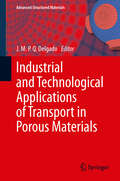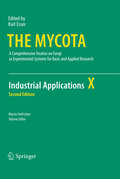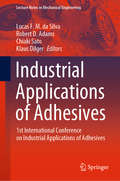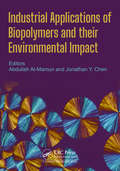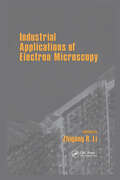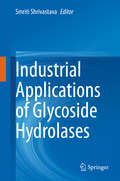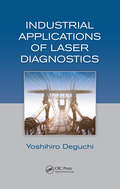- Table View
- List View
Indra's Net and the Midas Touch: Living Sustainably in a Connected World
by Leslie Paul ThieleAn exploration of the impact of unintended consequences in an interdependent world and of the opportunities for creativity and community.We live today in a global web of interdependence, connected technologically, economically, politically, and socially. As a result of these expanding and deepening interdependencies, it has become impossible fully to control—or foretell—the effects of our actions. The world is rife with unintended consequences. The first law of human ecology—which declares that we can never do merely one thing—is a truth we ignore at our peril. In Indra's Net and the Midas Touch, Leslie Paul Thiele explores the impact of interdependence and unintended consequences on our pursuit of sustainability. Unfortunately, good intentions provide no antidote to the law of unintended consequences, and proffered cures often prove worse than the disease. Biofuels developed for the purpose of reducing carbon emissions, for example, have had the unintended effect of cutting off food supplies to the needy and destroying rain forests. We must fundamentally transform our patterns of thinking and behavior. Thiele offers the intellectual and moral foundations for this transformation, drawing from ecology, ethics, technology, economics, politics, psychology, physics, and metaphysics. Awareness of our interconnectedness, he writes, stimulates creativity and community; it is a profound responsibility and a blessing beyond measure.
Induced After Death Communication: A New Therapy for Healing Grief and Trauma
by Allan L. Botkin R. Craig HoganInduced After-Death Communication (IADC) is a new therapy for grief and trauma that has helped thousands of people come to terms with their grief by allowing them the experience of private communication with their departed loved ones. Botkin, a clinical psychologist, created the therapy while counseling Vietnam veterans in his work at a Chicago area VA hospital. Botkin recounts his initial accidental discovery of IADC during therapy sessions with Sam, a Vietnam vet haunted by the memory of a Vietnamese girl he couldn't save. During the session, quite unexpectedly, Sam saw a vision of the girl's spirit, who told him everything was okay; she was at peace now. This single moment surpassed months-years-of therapy, and allowed Sam to reconnect with his family. Since that 1995 discovery, Botkin has honed IADC and used it to successfully treat countless patients-the book includes dozens of case examples-and has taught the procedure to therapists around the country. Induced After-Death Communication is the inside story of a revolutionary therapy that will profoundly affect how grief and trauma are understood and treated.
Induced Effects Of Genotoxic Agents In Eukaryotic Cells
by Toby G. RossmanThis book provides an understanding of the consequences of induced proteins in the toxicological response of cells to chemical and radiation damage to DNA and will be helpful in creating proper mathematical models for extrapolation to low doses and assessing human exposure or cellular injury.
Induced Genotoxicity and Oxidative Stress in Plants
by Zeba Khan Mohd Yunus Khalil Ansari Durre ShahwarThis book focuses on the effects of genotoxic agents causing oxidative stress in plants. The book explores different kind of chemicals which induces genotoxicity, their mechanism of action and effects on plant health. Impacts at the physiological and molecular levels are discussed. The book is of interest to teachers, researchers and plant scientists. Also the book serves as additional reading material for undergraduate and graduate students of agriculture, forestry, ecology, soil science, and environmental sciences. National and international agricultural scientists will also find this to be a useful read.
Induced Mutation Breeding
by Subodh Kumar DattaThe book is an excellent reference collection of the research conducted by different workers on induced mutagenesis, worldwide, for more than 80 years. One can get almost all mutation breeding references at one place. The book gives a coherent and concise account of all the important and relevant aspects related to induced mutagenesis with an emphasis on recent developments in the field of crop improvement. The references have been arranged crop wise and important topic wise which deal with not only classical mutation breeding but also spontaneous mutations, somaclonal variations, nanoparticles, and relevant modern aspects. The book highlights 22 chapters covering holistic information on almost all important components such as radiosensitivity, chromosomal and morphological abnormalities, detection of mutation, management of chimera, present status of mutation etc.) of Mutation Breeding. Chapters are very informative, and one can follow the references on crop and aspect basis since the start of mutation breeding work. This book is an excellent resource for researchers and students for understanding proper applications of induced mutations in crop improvement and biological research. It is of interest and useful to graduate and postgraduate students, horticulturists, floriculturists, agricultural scientists, and breeders related to crop improvement program.
Induced Pluripotent Stem: Methods and Protocols (Methods in Molecular Biology #2454)
by Andras Nagy Kursad TurksenThis extensive new edition presents protocols reflecting the great strides made in the study of induced pluripotent stem (iPS) cells. The collection explores new and improved methods for the generation, expansion, and maintenance of iPS cells from different tissue types, characterization of their differentiation pathways along different lineages, and their potential utility in tissue repair and regeneration. Written for the highly successful Methods in Molecular Biology series, chapters include introductions to their respective topics, lists of the necessary materials and reagents, step-by-step, readily reproducible laboratory protocols, and tips on troubleshooting and avoiding known pitfalls. Comprehensive and up-to-date, Induced Pluripotent Stem (iPS) Cells: Methods and Protocols, Second Edition aims to arm stem cell biologists, both novice and expert, with invaluable protocols that are currently being used in various laboratories around the world.
Induced Pluripotent Stem Cells
by Sibel YildirimInduced Pluripotent Stem (iPS) cells are mature cells that have been genetically reprogrammed so that they return to their embryonic state. It is not yet known if iPS stem cells and embryonic stem cells differ significantly. Today many fundamental belief systems in biology are shifting towards accepting that mature body cells can be reverted to an embryonic state without the help of eggs or embryos. With their changed identities, iPS cells are then ready to serve as new tools for research in the fields of disease pathogenesis, drug discovery, oncology, and cell transplantation. One example of this would be using iPS from a patient's mature cells to repair damaged tissue; it is thought that there would be very low incidence of rejection of the 'new' tissue in these cases. For the last four years, this therapeutic promise has been studied by hundreds of researchers worldwide in an effort to understand the ability of these cells to reverse their biological clocks.
Induced Pluripotent Stem Cells and Human Disease: Methods and Protocols (Methods in Molecular Biology #2549)
by Kursad TurksenThis detailed volume presents a series of protocols that are representative of recent developments and improvements in induced pluripotent stem cells (iPS cells) and corresponding human disease models. Reflecting the latest technology for generating induced pluripotent stem cells (iPS cells) and their initial characterization, the book explores techniques invaluable both for studies of disease-specific cell types and for their potential applications in regenerative medicine. Written for the highly successful Methods in Molecular Biology series, chapters include introduction to their respective topics, lists of the necessary materials and reagents, step-by-step and readily reproducible laboratory protocols, as well as tips on troubleshooting and avoiding known pitfalls. Authoritative and practical, Induced Pluripotent Stem Cells and Human Disease: Methods and Protocols serves as a vital guide that is valuable for not only experts but also novices in the stem cell field.
Induced Pluripotent Stem Cells in Brain Diseases
by Dwayne Holmes Judith Wagner Vivi M. Heine Stephanie DoovesBrain diseases can have a large impact on patients and society, and treatment is often not available. A new approach in which somatic cells are reprogrammed into induced pluripotent cells (iPS cells) is a significant breakthrough for regenerative medicine. This promises patient-specific tissue for replacement therapies, as well as disease-specific cells for developmental modeling and drug treatment screening. However, this method faces issues of low reprogramming efficiency, and poorly defined criteria for determining the conversion of one cell type to another. Cells contain epigenetic "memories" of what they were that can affect reprogramming. This book discusses the various methods to reprogram cells, the control and determination of cell identity, the epigenetic models that have emerged and the application of iPS cell therapy for brain diseases, in particular Parkinson's disease and Vanishing White Matter (VWM).
Induced Representations of Locally Compact Groups
by Eberhard Kaniuth Keith F. TaylorThe dual space of a locally compact group G consists of the equivalence classes of irreducible unitary representations of G. This book provides a comprehensive guide to the theory of induced representations and explains its use in describing the dual spaces for important classes of groups. It introduces various induction constructions and proves the core theorems on induced representations, including the fundamental imprimitivity theorem of Mackey and Blattner. An extensive introduction to Mackey analysis is applied to compute dual spaces for a wide variety of examples. Fell's contributions to understanding the natural topology on the dual are also presented. In the final two chapters, the theory is applied in a variety of settings including topological Frobenius properties and continuous wavelet transforms. This book will be useful to graduate students seeking to enter the area as well as experts who need the theory of unitary group representations in their research.
Inductance
by Clayton R. PaulThe only resource devoted Solely to InductanceInductance is an unprecedented text, thoroughly discussing "loop" inductance as well as the increasingly important "partial" inductance. These concepts and their proper calculation are crucial in designing modern high-speed digital systems. World-renowned leader in electromagnetics Clayton Paul provides the knowledge and tools necessary to understand and calculate inductance.Unlike other texts, Inductance provides all the details about the derivations of the inductances of various inductors, as well as:Fills the need for practical knowledge of partial inductance, which is essential to the prediction of power rail collapse and ground bounce problems in high-speed digital systemsProvides a needed refresher on the topics of magnetic fieldsAddresses a missing link: the calculation of the values of the various physical constructions of inductors--both intentional inductors and unintentional inductors--from basic electromagnetic principles and lawsFeatures the detailed derivation of the loop and partial inductances of numerous configurations of current-carrying conductorsWith the present and increasing emphasis on high-speed digital systems and high-frequency analog systems, it is imperative that system designers develop an intimate understanding of the concepts and methods in this book. Inductance is a much-needed textbook designed for senior and graduate-level engineering students, as well as a hands-on guide for working engineers and professionals engaged in the design of high-speed digital and high-frequency analog systems.
Inductance Calculations: Working Formulas And Tables (Dover Books on Electrical Engineering)
by Frederick W GroverThis authoritative compilation of formulas and tables simplifies the design of inductors for electrical engineers. It features a single simple formula for virtually every type of inductor, together with tables from which essential numerical factors may be interpolated. Although compiled in the 1940s, before calculators and computers, this book provides fundamental equations that professionals and practitioners can use to produce algorithms for computer programs and spreadsheets.Starting with a survey of general principles, it explains circuits with straight filaments; parallel elements of equal length; mutual inductance of unequal parallel filaments and filaments inclined at an angle to each other; and inductance of single-layer coils on rectangular winding forms. Additional topics include the mutual inductance of coaxial circular filaments and of coaxial circular coils; self-inductance of circular coils of rectangular cross section; mutual inductance of solenoid and a coaxial circular filament and coaxial single-layer coils; single-layer coils on cylindrical winding forms; and special types of single-layer coil. An esteemed reference, this volume belongs in the library of every electrical engineer.
Induction Accelerators
by Ken Takayama Richard J. BriggsA broad class of accelerators rests on the induction principle whereby the accelerating electrical fields are generated by time-varying magnetic fluxes. Particularly suitable for the transport of bright and high-intensity beams of electrons, protons or heavy ions in any geometry (linear or circular) the research and development of induction accelerators is a thriving subfield of accelerator physics. This text is the first comprehensive account of both the fundamentals and the state of the art about the modern conceptual design and implementation of such devices. Accordingly, the first part of the book is devoted to the essential features of and key technologies used for induction accelerators at a level suitable for postgraduate students and newcomers to the field. Subsequent chapters deal with more specialized and advanced topics.
Induction and Intuition in Scientific Thought (Routledge Library Editions: History & Philosophy of Science)
by P B MedawarOriginally published in 1969. This book explains what is wrong with the traditional methodology of "inductive" reasoning and shows that the alternative scheme of reasoning associated with Whewell, Pierce and Popper can give the scientist a useful insight into the way he thinks.
Induction of Bone Formation in Primates: The Transforming Growth Factor-beta 3
by Ugo RipamontiThe effects of the bone morphogenetic proteins (BMPs) family on bone formation are well documented, but the transforming growth factor (TGF)-beta ( isoforms are much less studied. The product of 20 years of study, Induction of Bone Formation in Primates: The Transforming Growth Factor- sums up editor Ugo Ripamonti's research into the osteogenic a
An Inductive Approach to Engineering Thermodynamics (Mechanical Engineering Series)
by George SidebothamThis textbook provides an alternative, inductive treatment of traditional Engineering Thermodynamics, e.g. energy and its transformations in engineering systems, and introduces the notion of eXergy. The book begins with energy methods developed in mechanics and transitions to thermodynamics by introducing both 1st and 2nd Laws of Thermodynamics immediately, incorporating more-advanced concepts using practical applications. This methodology continues throughout the text, wherein consideration of a specific example leads to general conclusions. At the same time, the author introduces eXergy, also called “Availability,” a measure of the potential of a substance to produce useful mechanical work in being brought from its current state to the conditions of the local environment.The book facilitates students’ understanding with workshop problem statements and guided spreadsheet.It is appropriate for a sophomore- or junior-level first course in thermodynamics and is restricted to “simple compressible substances” with no formal chemical reaction development. Mechanical engineering applications are the primary target, where several follow-up courses would follow (fluid mechanics, heat transfer, and a 2nd thermos course). Civil or electrical engineering students could benefit from just this course, and chemical engineering programs could develop chemically reacting and non-ideal applications in follow-up courses.
Industrial and Biotechnological Applications of Algae
by Yadvinder Singh J. I. S. Khattar D. P. Singh Rupinder Pal SinghThis book discusses the diverse and promising uses of algae in various industries and biotechnological processes. Algae, as a photosynthetic organism, is found in varied habitats around the world. It has garnered significant attention in recent years due to its remarkable potential as a sustainable and environmentally friendly resource. This book aims to bridge the gap between scientific knowledge and practical applications by exploring the cutting-edge research, innovations, and emerging trends in the field of algal biotechnology. With a focus on both industrial and biotechnological aspects, this book delves into the wide array of applications that algae offers. From renewable energy and wastewater treatment to pharmaceuticals, nanomaterial, cosmetics, and personal care products, each chapter examines a specific area where its unique properties are harnessed to address pressing global challenges. Additionally, the book explores the role of algae in improving food production, supporting aquaculture, and contributing to carbon capture and utilization efforts. This book is a resource for scientists, researchers, industry professionals, and policymakers that highlights the potential of algae as a sustainable and versatile solution across multiple sectors. By presenting the latest advancements in algal biotechnology, the book seeks to inspire further research, foster innovation, and promote the integration of algae into mainstream industrial and biotechnological practices.
Industrial and Laboratory Measuring Systems: Sensors, Distributed, Modular and Wireless Systems (River Publishers Series in Energy Management)
by Josef VedralThis book describes the types and properties of computer controlled industrial and laboratory measuring systems for data acquisition and the processing signals of typical physical sensors. It is intended for users and designers of digital measurement systems working in laboratories and industry, scientific and research environments, and students taking relevant courses.An overview of the properties of these sensors used in laboratory and industrial environments is provided. The chapters describe the properties of computers used in measurement systems, including plug-in cards and the IEEE-488 protocol. The following chapters describe the types and properties of distributed and modular measuring systems and systems using data networks, including wireless measuring systems. The final chapters describe methods of digitization, reconstruction and signal processing in measurement systems in time and frequency domains.
Industrial and Technological Applications of Transport in Porous Materials
by J.M.P.Q. DelgadoThe purpose of this book, Industrial and Technological Applications of Transport in Porous Materials, is to provide a collection of recent contributions in the field of heat and mass transfer in porous media and their industrial and technological applications. The main benefit of the book is that it discusses some of the most important topics related to transport phenomenon in engineering and their future applications. It includes a set of new technological applications in the field of heat and mass transfer phenomena in a porous medium domain, such as, drying technology, filtration, infrared thermography, energy, recycling, etc. At the same time, these topics will be going to the encounter of a variety of scientific and engineering disciplines, such as chemical, civil, agricultural, mechanical engineering, etc. The book is divided in several chapters that intend to be a resume of the current state of knowledge for benefit of professional colleagues.
Industrial Applications
by Martin HofrichterThis volume gives a survey of the state of the art in the traditional fields of industrial mycology as well as of selected novel applications of fungi. The first section deals with the use of fungi in the production and processing of bread, cheese, beer and wine, traditional Asian fermentation products and edible mushrooms. The second section is devoted to the production of fungal metabolites and enzymes representing value-added products. In addition to antibiotics, alkaloids organic acids, vitamins and industrial enzymes, which have successfully been in use for decades, it is also dedicated to fungal metabolites, such as insecticidal and nematicidal compounds, immunosurppressants and flavors with promising biotechnological potential. In the next section, the recent developments in fungal biotransformation of small molecules, the bioconversion of lignocelluloses as well as the use of fungi in metal recovery are presented. The final part introduces some innovative new trends in the field of applied mycology: the preparation of fungal bioherbicides, recent genomic approaches for the identification of biopolymer degrading enzymes, current developments in using oxidative enzymes from fungi as well as new attempts to transfer fungal remediation technologies into practice.
Industrial Applications of Adhesives: 1st International Conference on Industrial Applications of Adhesives (Lecture Notes in Mechanical Engineering)
by Lucas F. M. da Silva Robert D. Adams Chiaki Sato Klaus DilgerThis book gathers selected papers presented at the 1st International Conference on Industrial Applications of Adhesives 2020 (IAA 2020). It covers a wide range of topics, including adhesive curing for electronic and automotive industries; adhesive testing with a torsion machine for rigorous mechanical properties determination; joint design using innovative techniques such as the meshless method; design methodologies in the automotive industry for joints under impact; temperature effects in joints typically found in civil engineering; and advanced nondestructive techniques such as terahertz spectroscopy to assess the durability of adhesive joints. Providing a review of the state-of the art in industrial applications of adhesives, the book serves as a valuable reference resource for researchers and graduate students interested in adhesive bonding.
Industrial Applications of Biopolymers and their Environmental Impact
by Abdullah Al-Mamun; Jonathan Y. ChenBiopolymers represent a carbon emission solution: they are green and eco-friendly with a variety of uses in biomedical engineering, the automotive industry, the packaging and paper industries, and for the development of new building materials. This book describes the various raw materials of biopolymers and their chemical and physical properties, the polymerization process, and the chemical structure and properties of biopolymers. Furthermore, this book identifies the drawbacks of biopolymers and how to overcome them through modification methods to enhance the compatibility, flexibility, physicochemical properties, thermal stability, impact response, and rigidity.
Industrial Applications Of Electron Microscopy
by Zhigang R. LiProviding proven strategies for solutions to research, development, and production dilemmas, this reference details the instrumentation and underlying principles for utilization of electron microscopy in the manufacturing, automotive, semiconductor, photographic film, pharmaceutical, chemical, mineral, forensic, glass, and pulp and paper industries
Industrial Applications of Glycoside Hydrolases
by Smriti ShrivastavaThis book gathers selected studies on the industrial applications of glycoside hydrolases (GHs), presenting an updated classification of these enzymes, and discussing their structure, mechanisms, and various approaches to improve their catalytic efficiency. Further, it explains the various industrial applications of glycoside hydrolases in food, effluent treatment, biofuel production, and the paper and pulp industries. Lastly, the book provides a comparative analysis of glycoside hydrolases and discusses the role of metagenomics in the discovery of industrially important enzymes. As such it is a thought-provoking, instructive and informative resource for biochemists, enzymologists, molecular biologists and bioprocess technologists.
Industrial Applications of Laser Diagnostics
by Yoshihiro DeguchiTighter regulations of harmful substances such as NOx, CO, heavy metals, particles, emissions from commercial plants and automobiles reflect a growing demand for lowering the anthropogenic burdens on the environment. It is equally important to monitor controlling factors to improve the operation of industrial machinery and plants. Among the many me
